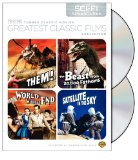| Reviews & Columns |
|
Reviews DVD TV on DVD Blu-ray 4K UHD International DVDs In Theaters Reviews by Studio Video Games Features Collector Series DVDs Easter Egg Database Interviews DVD Talk Radio Feature Articles Columns Anime Talk DVD Savant Horror DVDs The M.O.D. Squad Art House HD Talk Silent DVD
|
DVD Talk Forum |
|
|
| Resources |
|
DVD Price Search Customer Service #'s RCE Info Links |
|
Columns
|
|
|
TCM Greatest Classic Films Collection: Sci-Fi Adventures
Warner Bros. // Unrated // February 2, 2010
List Price: $27.92 [Buy now and save at Amazon]
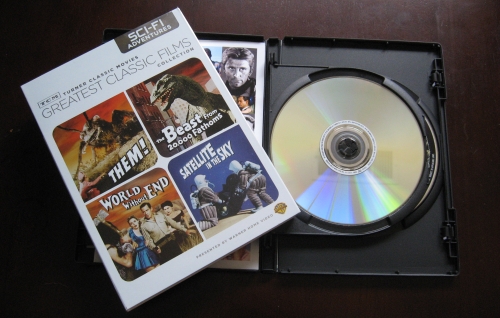
The face of the science-fiction genre has evolved quite a bit since the '50s, a period where the likes of The Day the Earth Stood Still tapped into a growing fear of alien invasion and Forbidden Planet dazzled with its iconic thrills. It's almost a pre-requisite to have a bowl of popcorn and a fizzy drink handy when cracking into these classics, for the sheer reasoning that, no matter how deep or dramatic they get, there's always a sense of cinematic joy to be had in watching something fantastical constructed from meager means. However, throughout the course of the genre's evolution, one thing hasn't changed: there's a lot of thematic depth stirring within their construction, which ranges from the precisely-executed nuclear allegories to, well, hair-brained construction of presupposed utopias and some rather kooky creatures.
That's where TCM's Greatest Classic Films Collection: Sci-Fi Adventures set comes in, a collection of stalwart films that aren't quite as readily knowable as household names like Godzilla (Gojira), Klaatu, and Robbie the Robot. Each of the discs replicate the content available on the previously-released versions of the films, which also includes double-feature offerings of the films in science-fiction / campy classics collections. One of the films, THEM!, is a classic and another, The Beast from 20,000 Fathoms, is a decent, technically-proficient picture, whereas the other two, World Without End and Satellite in the Sky, fit snugly in the niche of passably watchable entries in the genre.
The Beast from 20,000 Fathoms (1953) --

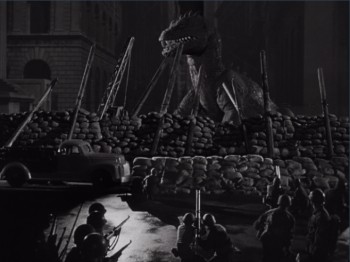 | 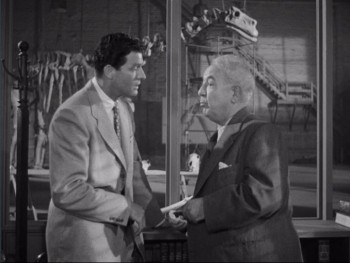 |
Though King Kong can be attributed as the original catalyst, both in its original run and its re-release in '52, Eugene Lourie's The Beast from 20,000 Fathoms really got things moving for creature features in the early '50s. An adaptation of a story from Ray Bradbury, it follows a group of nuclear bomb experts as they test weaponry above the Arctic Circle. Their testing has had a dangerous side effect: a dinosaur buried deep within the ice, a four-legged "Rhedosaurus", has been jolted back to life and, apparently, woke up on the wrong side of the bed. While a scientist. Professor Tom Nesbitt (Paul Hubschmid), who saw the monster in the Arctic adamantly tries to tell the military about what he saw, which only creates concern for his sanity, the dinosaur travels along the Arctic Current -- tearing up lighthouses and boats along the way -- until it comes on-shore on the eastern seaboard.
As with many early additions to a genre, The Beast from 20,000 Fathoms is more noteworthy for its technical merits -- the first solo effort from special-effects master Ray Harryhausen -- than its drawn-own, offhand story. Harryhausen's stop-motion construction with the predacious dinosaur still works well, making ample use of set design with destroyed lighthouses and crunched cars in the metropolitan area. It's within the caution-to-the-wind storytelling where Lourie's picture only holds up as a popcorn-muncher; everything happens much too effortlessly, from convincing an upmost paleontologist (Cecil Kellaway) of the dinosaur's existence, to the plothole-ridden conclusion in metro NYC that messily creates more questions than it answers. Still, all that's dismissible for the opportunity to watch Godzilla's influential predecessor snarl at army dudes, get zapped by high-volt wiring, and tear an amusement park to shreds.
Subtitles: English, French, Spanish, Portuguese, and Japanese.
THEM! (1954) --

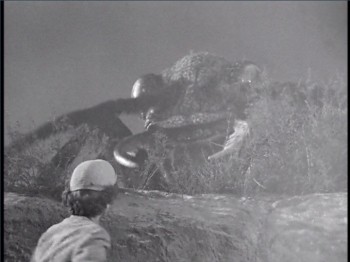 | 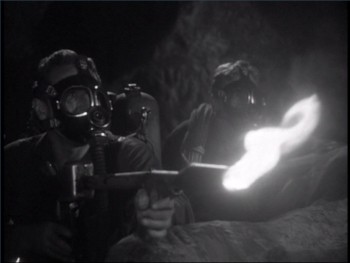 |
Shortly after The Beast from 20,000 Fathoms raked in roughly $5million in box office take, a high number at the time, Warner Bros. aimed to duplicate its success with another creature feature -- THEM! You'd probably expect something silly or campy with that title, but that's certainly not the case. It starts out as an effective detective story, complete with a slack-jawed, speechless little girl who's just seen something terrifying happen to her family. A giant hole has been torn out of the side of her trailer, something that couldn't be done by any normal means. Events like this continue to pop up around the New Mexico town, all of them experiencing massive damage and no theft. When a renowned scientist (Edmund Gwenn) and his daughter (Joan Weldon) come into town to investigate a few prints determined to possibly be of an insect, he and the authorities -- the police and FBI -- discover that things are far worse than having to deal with just one singular, large entomological threat.
What director Gordon Douglas dishes out with his adaptation of George Yates' story is one of the best of the "creature feature" genre, a stone-faced, brilliantly-paced chiller that combines superb performances and self-aware, tight production design. He makes strategic usage of the excellently assembled ant models, Oscar-nominated creations that are dated but still constructed with an enduring aesthetic that's charming and, in ways, still unnerving. If for nothing else, the film is worth watching for the suspense generated within two dark, intense sequences where these crawlers might be lurking around any of several corners -- one that finds our crew diving into the depths of a giant anthill, and the other where a huge team of soldiers weave through an atmospheric sewer system. Also, it's with THEM! that we see realized, figurative jabs at nuclear warfare, tapping into a fear generated after the dust had somewhat settled from the bombings in WWII. But that's just icing on the cake when talking about this simple yet fearsome monster thriller, one that still carries a suspenseful punch to this day.
Subtitles: English, French and Spanish.
World Without End (1956) --

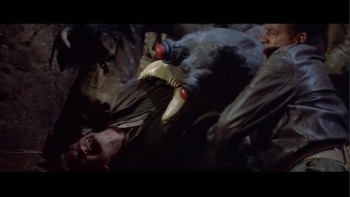 | 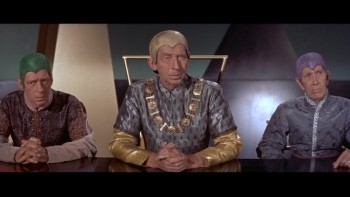 |
Edward Bernds' World Without End carries the distinction of being one of the first science-fiction films in Cinemascope, but the merit slows down drastically from there as this campy talker wears our interest level thin. It's a shame too, because the story's actually pretty cool in a pseudo-Time Machine kind of way. Set in 1957, four American rocketeers (one of which is played by none other than Time Machine star Rod Taylor) are knocked out while traveling at high velocities on a trip home from Mars. They hit a time loop and are taken many years into the future, later discovered to be in the 26th Century, where humanity has either mutated into mangled beasts on the surface -- along with some rather massive spiders lurking in caves -- or retreated into safe housing underground. Oddly, our main characters discover that the feeble, old hermit men have lost their lust for life, exploration, and reinstatement of their place on Earth, something that doesn't seem to be a problem for their scantly-clad, lively legs-for-days women, who marvel at these new strapping adventurers like hunks of gold buried for ages.
When it's not throwing in boringly-shot wrasslin' matches between the four main characters and their mutated villains (arachnid and mammal alike), most of World Without End focuses on conversations between our four guys about being lost in time, then towards the elders in the underworld about their need for help. It revolves around a premise that, when looking outside the box, I actually dig quite a bit; their conversations address the receding oomph behind humanity's zeal for life, how holing it up in an underground lair is essentially a coward's way of living, and that progress is essential to survival. However, the way it's executed can be droll, cheeky, and aggravating in heavy spurts, rambling endlessly while throwing its thematic premise under the bus for '50s-era giggles. Moreover, the production design is, naturally, laughably dated -- try watching that spider attack without chuckling -- though the skimpy costume design draped over Nancy Gates offers at least a few ogle-worthy sequences. However, it's these goofy indulgences that still give the flick a few rays of enjoyment, though the balance struck between sociological ideas and a sense of humor never evens out.
Subtitles: English and French.
Satellite in the Sky (1956) --

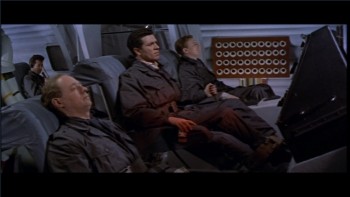 | 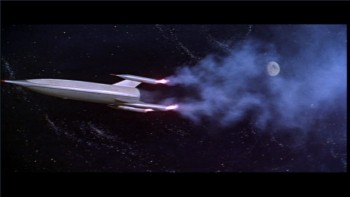 |
Satellite in the Sky was also shot in '56 with the beaming color of Cinemascope, just like World Without End, but they couldn't be more different; where Edward Bernds' production has aged into a campy diversion with pert goofiness in its favor, this British sci-fi drama merely zips along with mediocrity and seriousness as its backburners. It's dull, in other words, but not really because of the story. Sandwiched in between stock footage of aircraft traveling to-and-fro down a taxiway and flying through the air, the story revolves around a group of men dedicated to taking a spacecraft that doubles as a satellite up beyond the stratosphere. What they eventually discover, after dodging the penmanship of an anti-progression reporter (Lois Maxwell), is that their experiment is actually being funded as a test mission for a new form of nuclear bomb, one that's only safe to be exploded in the expanses of space.
Though we've got a blossoming relationship between the reporter and one of the crewmen (Kieron Moore) on the ship, and model spacecraft flying on strings, Satellite in the Sky is all business. Serious, stiff acting comes from those involved, crafting meager characters that aren't particularly gripping. The events that transpire around them don't really offer much more than very mild momentum, only picking up the lightest amount of intrigue when it leads up to the revelation about the bomb. Once that fact has been revealed, some tension can be rustled up from the mix, but the overly-talky nature of it all just drags the otherwise appealing story to a snail's pace. Sure, the dialogue about technological advancement can be interesting, and the competent look of the film consistently feels authentic, but there's really very little to grab a hold of here.
Subtitles: English and French.
Video and Audio:
We've got one dual-sided disc that holds the two black and white films, THEM! and The Beast from 20,000 Fathoms, on one side and the other which replicates the 16x9-enhanced quality from the WB Double Feature of World Without End and Satellite in the Sky -- both framed in Cinemascope's 2.35:1 widescreen ratio. The quality fluctuates drastically between them and; THEM! and The Beast from 20,000 Fathoms are both sharp and sport competent contrast, while World Without End's damaged yet clear transfer easily towers over the other widescreen presentation in image refinement. Satellite in the Sky is murky and poorly detailed, but at least it's a widescreen enhanced version of the film.
Audio comes in Dolby Digital Mono tracks for each of the films, which mostly support them with enough clarity and quality to retain their essence as sci-fi pictures. THEM! sports a rather active soundtrack, with the ants' sounds and fire blasts, and they're handled with plenty of age-latched robustness. The rest are mostly uninteresting yet supportive of the content, from the destruction in The Beast from 20,000 Fathoms and the explosions / afterburner blasts in World Without End and Satellite in the Sky.
Special Features:
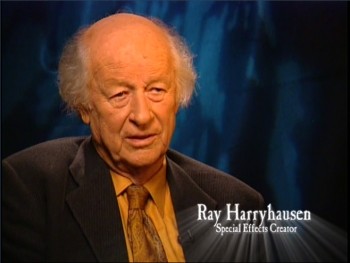 |  |
| | |
| The Beast from 20,000 Fathoms: Cast & Crew (Text) The Rhodesaurus and the Rollercoaster (6:12, 4x3) Harryhausen & Bradbury: Unfathomable Relationship (16:50, 4x3) Coming Attractions (4:05, 4x3) | THEM! Who's Who (Cast & Crew, Textual) Bugged at the Movies (Stories, Textual) Photo Gallery Captured on Tape (3:17, 4x3) |
| World Without End: Bare-boned DVD | Satellite in the Sky: Bare-boned DVD |
Final Thoughts:
If you don't own any of these classics, then this TCM Greatest Classic Films Collection: Sci-Fi Adventures bundle will be a worthwhile addition to your collection. Bear in mind, though, that there's an in-print, lower-priced Double Feature from Warner Bros. that contains both THEM! and The Beast from 20,000 Fathoms that comes with a higher overall recommendation than this batch. Still, the films available here -- a mix of contemplative sci-fi and schlocky camp -- easily come with a Recommendation, especially if you've got a bunch of people over for a night of popcorn-tossing, soda-guzzling entertainment.
|
| Popular Reviews |
| Sponsored Links |
|
|
| Sponsored Links |
|
|
| Release List | Reviews | Shop | Newsletter | Forum | DVD Giveaways | Blu-Ray | Advertise |
|
Copyright 2024 DVDTalk.com All Rights Reserved. Legal Info, Privacy Policy, Terms of Use,
Manage Preferences,
Your Privacy Choices | |||||||









